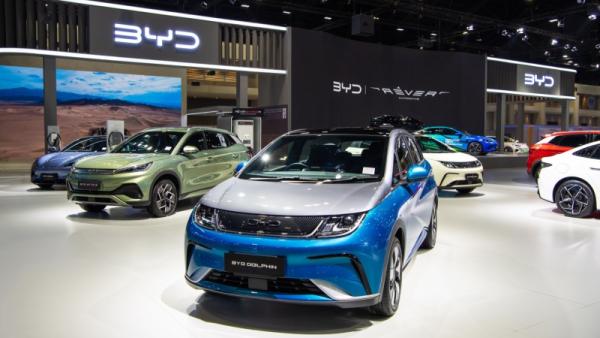Charging ahead or stalled out: Can geopolitics short-circuit Australia's electric vehicle surge?
Chatchai Somwat / Shutterstock

Marina Yue Zhang, Associate Professor – Research, Australia-China Relations Institute, University of Technology Sydney |

Elena Collinson, Manager, Research Analysis, Australia-China Relations Institute, University of Technology Sydney |
Note: This article appeared in Australian Outlook on March 20 2024.
The year 2023 was a watershed for Australians in the adoption of electric vehicles (EVs). After years of gradual uptake, the market saw unprecedented growth. Specifically, battery EVs comprised approximately 7.4 percent of light vehicle sales — a more than fourfold increase from their 1.8 percent market share of new car sales in 2022.
Despite these inroads, Australia still lags behind many nations in the Organisation of Economic Co-operation and Development (OECD) in adopting EVs. Three main factors explain this phenomenon.
First, Australia’s vast landmass and sparse population density, especially outside urban areas, present significant challenges in creating a widespread and accessible network of EV charging stations. This lack of infrastructure contributes to ‘range anxiety‘ among prospective EV buyers.
Second, the higher price of EVs also deters consumers from making the shift. Unlike leading EV markets such as Norway, Sweden, and China, Australia lacks the incentives and regulatory framework necessary to encourage EV adoption.
Third, access to new EV models in Australia is delayed compared to other countries.
However, the tide may be turning. Australia’s National Electric Vehicle Strategy, unveiled in 2023, aims to augment the supply of affordable EVs, underpinning the government’s commitment to infrastructure development and a smoother EV transition. Federal incentives, alongside substantial state and territory-level subsidies, are starting to make an impact. The Australian Capital Territory leads the charge with the most financial and non-financial incentives, propelling it to the forefront of EV adoption rates nationwide.
The most direct impact of subsidies is their ability to substantially reduce upfront costs, often bridging the price gap with internal combustion engine vehicles (ICEs), and encouraging consumers to shift to EVs. Beyond financial incentives, visible government support for clean energy and the EV transition generates media coverage and public discussion, raising awareness about EVs and their benefits. This creates a ripple effect, leading more consumers toward EVs.
Amid this shift, a player making a significant impact in the Australian market is the Chinese automaker BYD. In January 2024, BYD outsold Tesla in Australia for the first time, marking a milestone in the country’s electric car sales race. BYD reported sales of 1,310 new vehicles, compared to 1,107 new Tesla cars.
While it remains to be seen whether BYD’s success is an indicator of a longer-term trend, the January 2024 figures appear to speak to the allure of lower price points, the offer of more diverse model ranges, and advanced technology.
Cumulatively, Tesla still holds a significant portion of the battery EV market in Australia. However, since Tesla’s Model Y and Model 3 are manufactured in its Gigafactory in Shanghai, the total market share of EVs made in China has reached 83 percent of Australia’s pure EV market. The market share of EVs carrying a Chinese brand or owned by Chinese firms — including BYD (14 percent), Geely Polestar 2 (7.3 percent), and SAIC MG (6.8 percent) — has amounted to about 30 percent.
BYD’s advancements in EV design and manufacturing, however, do not themselves guarantee its success, especially in the global market. Indeed, China’s rapid progress in EV production capacity and technology — producing nearly 80 percent of the world’s EVs and holding at lead half of the global patents related to batteries — has raised concerns, particularly among Western countries, about the potential risks of over-reliance on Chinese EV exports. In addition, China’s ascendancy in this sector could disrupt industries in nations where automotive manufacturing is a cornerstone of the economy, such as the United States, Germany, and Japan. This ripple effect extends beyond automakers, affecting the complex network of components and parts suppliers in these countries.
For example, China’s rise in the EV sector has drawn scrutiny over the subsidies it receives from the Chinese government, leading to a European Union anti-subsidy investigation. In the US, President Joe Biden has initiated steps that could potentially block the import of Chinese EVs, citing national security concerns. One specific concern articulated by the Biden administration is that software embedded in Chinese EVs might collect sensitive driving data from Americans and transmit them back to China.
The question is, will Australia follow suit?
Even if Canberra does not impose trade restrictions on EVs from China, consumers’ preferences for certain brands is still exposed to influence by politics, driven by geopolitical risk spillover — the phenomenon where political tensions and events between nations extend beyond the realm of pure diplomacy to affect other areas such as trade, investment, social and cultural exchanges, and, consequently, consumer preferences.
Political distrust can spill over into public opinion through media coverage. For example, increased tensions between Australia and China during the Covid-19 pandemic heightened nationalistic sentiments on both sides. Such sentiments may lead consumers to avoid products from a country they believe acts in ways that conflict with their values, whether due to concerns about human rights, strategic competition, or ideological differences.
Negative sentiments stemming from strained bilateral relations can influence consumers to either avoid or favour products from a specific country, driven by political considerations or perceived risks associated with those products. In the worst-case scenario, akin to a ‘boycott,’ this might involve actively and intentionally avoiding purchases from countries viewed with distrust. A heightened sense of nationalism may lead some individuals to prefer non-Chinese brands, even if those options are less advanced in EV technology.
To be sure, this possibility remains nascent. A poll of 2,000 Australians across all states and territories by the Australia-China Relations Institute last year indicated that, since 2021, Australians are increasingly seeing the Australia-China relationship as an economic opportunity as opposed to a risk. The same poll also showed that the resumption of high-level political dialogue, and the thaw in relations between Australia and China has been generally positively received by Australians, with the Albanese-Labor government’s policy of ‘stabilising’ the relationship appearing to be aligned with public sentiments.
However, the future remains uncertain. Overall, Australia’s EV saga is more than a tale of market trends and technological adoption. It is a narrative deeply intertwined with the global geopolitical milieu, where the road to electrification is as much about navigating diplomatic currents as it is about charging infrastructure and incentives. The question remains: whether geopolitics will stall Australia’s EV uptake, or can the nation steer through the complexities of an increasingly polarised world.
Authors
Dr Marina Yue Zhang is Associate Professor – Research at the Australia-China Relations Institute, University of Technology Sydney.
Elena Collinson is head of analysis at the Australia-China Relations Institute, University of Technology Sydney.

